Pets, display, and decoration are some of the roles a tarantula can fulfill in our homes. These amazing animals are popular pets, valued for their beauty and interesting behavior. They’re also very diverse, having more than 5,000 different species to choose from.
Having so many alternatives for a pet may make the acquisition process overwhelming, so we’ve created a list of top tarantulas to make this easier for you.
Arboreal tarantulas have a slim figure and often fast movements that will leave you amazed. They spend their lives in the trees, so decorating their enclosures is usually a lot of fun. If you love arboreal tarantulas and you’re looking to have a great collection of them, check our list of the top ten arboreal tarantulas to see if there are any you’re missing.
Top 10 Arboreal Tarantula Species
1. Gooty Sapphire Ornamental Tarantula
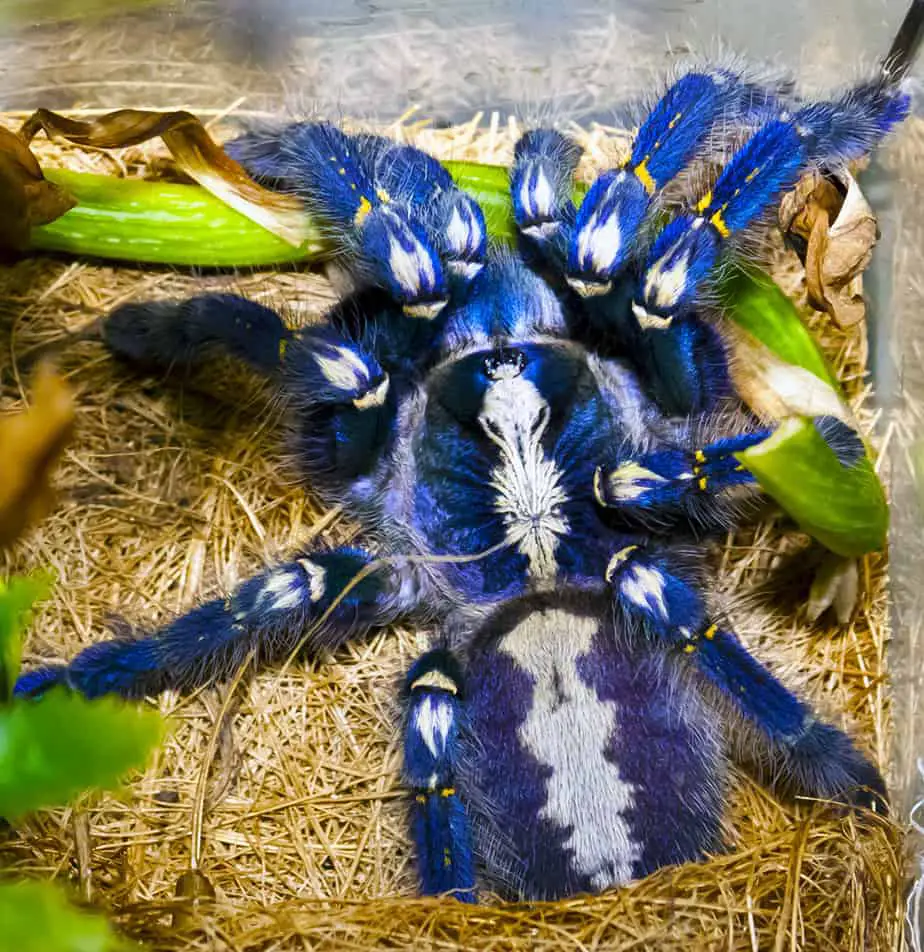
| Common Name | Gooty Sapphire Ornamental Tarantula |
| Scientific Name | Poecilotheria Metallica |
| Type | Old World, Arboreal |
| Leg Span | 8 inches (20cm) |
| Lifespan | Females 12 years / Males 4 years |
| Experience Level | Expert |
At the top of our list lies the Gooty Sapphire Tarantula, a spider so stunning that looking at her seems like a dream. Most of her body is covered with electric blue, with white diamond patterns over its abdomen and legs. She spends plenty of time out in the open, and you can even hold them communally. Therefore, she’s an incredible display spider.
It should be noted though this while beautiful, this species is not recommended for beginners. They can use their fangs to inject potent venom and are also quite defensive.
2. Antilles Pinktoe Tarantula
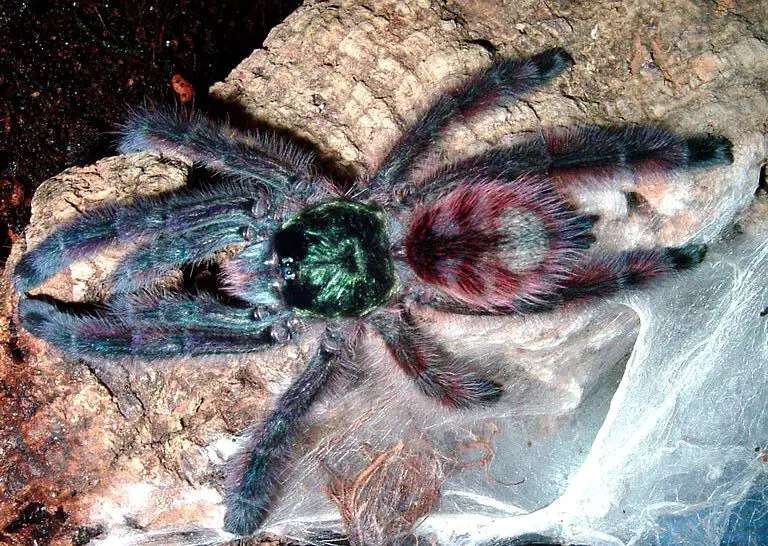
| Common Name | Antilles Pintkoe Tarantula |
| Scientific Name | Caribena versicolor |
| Type | Arboreal |
| Leg Span | 6 inches (15cm) |
| Lifespan | Females 12 years / Males 2-3 years |
| Experience Level | Beginner |
The Caribena Versicolor gets second place for her interesting and beautiful appearance. She boasts purple, red, and blue tones over her body as an adult. She also displays bright greens in her body during her development stages, so it’s interesting to see the way her appearance keeps evolving after each molt. Combine this with her weak venom and peaceful demeanor, and you’ll get a fantastic pet, even for beginners.
3. Amazon Sapphire Tarantula
| Common Name | Amazon Sapphire Tarantula |
| Scientific Name | Ybyrapora diversipes |
| Type | New World, Arboreal, Bird Eater |
| Leg Span | 5.5 inches (14cm) |
| Lifespan | Females 12-14 years / Males 3-4 years |
| Experience Level | Intermediate |
The Amazon Sapphire Tarantula gets third place in our top thanks to its beautiful colors. Bright green, pink, red, and blue form beautiful patterns over their carapace.
They’re also related to the Avicularia avicularia, so there’s a chance it turns out to be a communal tarantula.
Sadly, they don’t retain these colors when they turn into adults, but it’s still a delight to see them grow as every molt comes with a renewed appearance.
4. Darth Maul Tarantula
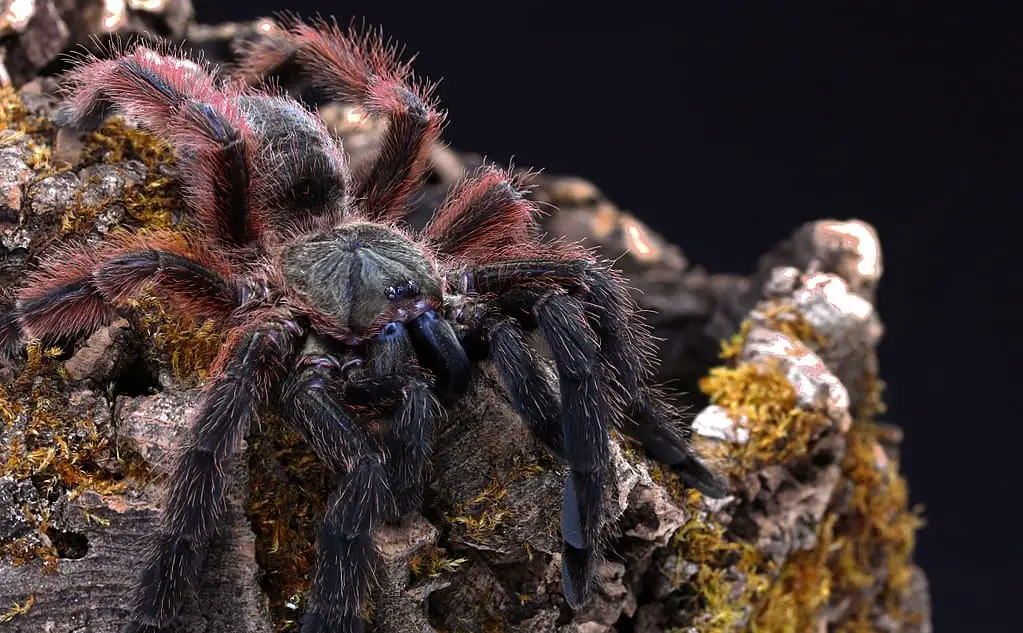
| Common Name | Darth Maul Tarantula |
| Scientific Name | Psalmopoeus victori |
| Type | New World, Arboreal |
| Leg Span | 5.5-6 inches (12-15cm) |
| Lifespan | Females 10-12 years / Males 2-3 years |
| Experience Level | Expert |
The Darth Maul Tarantula gets fourth place on our list for having a striking red and black appearance and a cool name. The first arboreal species ever discovered in Mexico has some Old World traits even though she’s a New World species.
She lacks urticating hair but makes up for it with her potent venom. She should only be kept by experienced hobbyists, but she’s a rewarding tarantula if you’re up to the challenge.
5. Singapore Blue Tarantula

| Common Name | Singapore Blue Tarantula |
| Scientific Name | Omothymus violaceopes |
| Type | Old World, Arboreal |
| Leg Span | 11 inches (28cm) |
| Lifespan | Females 14 years / Males 5 years |
| Experience Level | Expert |
Bluish purple legs, red setae, and white carapace give the Singapore Blue Tarantula a mesmerizing look. These spiders are also huge, reaching up to eleven inches of diagonal leg span.
They’re also aggressive eaters with an excellent feeding response. Even though they may be quick to throw a threat posture, the truth is that they’d rather flee than fight, which means you’re under less of a risk of getting bitten.
6. Fringed Ornamental Tarantula
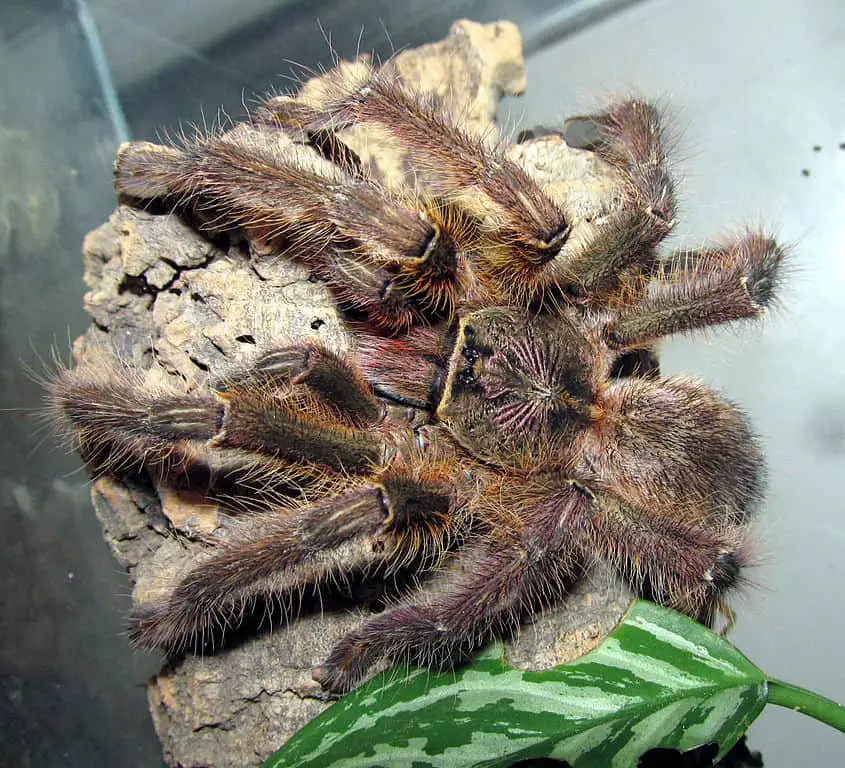
| Common Name | Fringed Ornamental Tarantula |
| Scientific Name | Poecilotheria ornata |
| Type | Old World, Arboreal, Bird Eater |
| Leg Span | 9.8 inches (25cm) |
| Lifespan | Females 12 years / Males 3 years |
| Experience Level | Expert |
No list of top arboreal tarantulas would be complete without the Poecilotheria ornata. A close cousin to the Gooty Sapphire Ornamental Tarantula, the FOT is a stunning tarantula that hobbyists often consider an important milestone.
Her beautiful black and white patterns combined with greenish-yellow make her beautiful. However, her venom is considered one of the strongest in the hobby, and she’s known for being fast and unpredictable; therefore, it’s a challenge that should only be assumed by the most experienced hobbyists.
7. Brazilian Jewel Tarantula
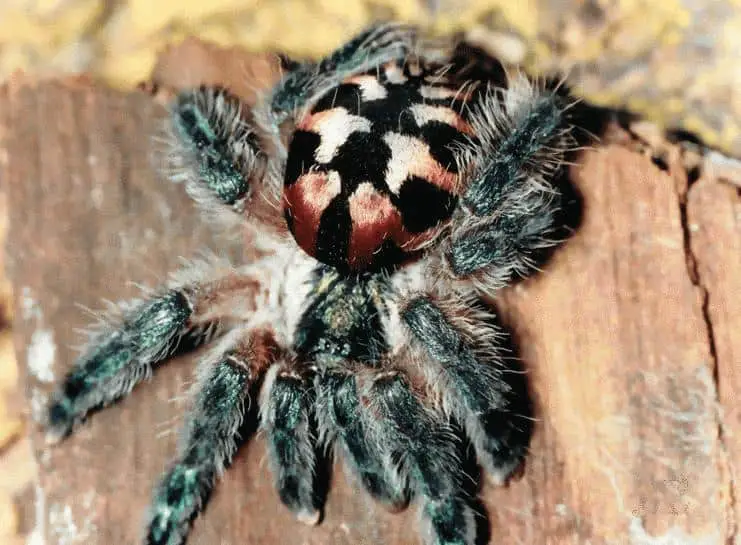
| Common Name | Brazilian Jewel Tarantula |
| Scientific Name | Typhochlaena seladonia |
| Type | New World, Arboreal, Dwarf Tarantula |
| Leg Span | 2-2.4 inches (4-6cm) |
| Lifespan | Unknown |
| Experience Level | Intermediate |
We still have a lot to learn about the Brazilian Jewel Tarantula. The Caribbean jewel is a dwarf tarantula with colors so bright and vivid that it seems unnatural.
She has an electric blue frame decorated with pinks, reds, and blacks with a beautiful pattern on her abdomen. She’s also harmless and docile, encouraging some hobbyists to handle them.
8. Venezuelan Suntiger Tarantula
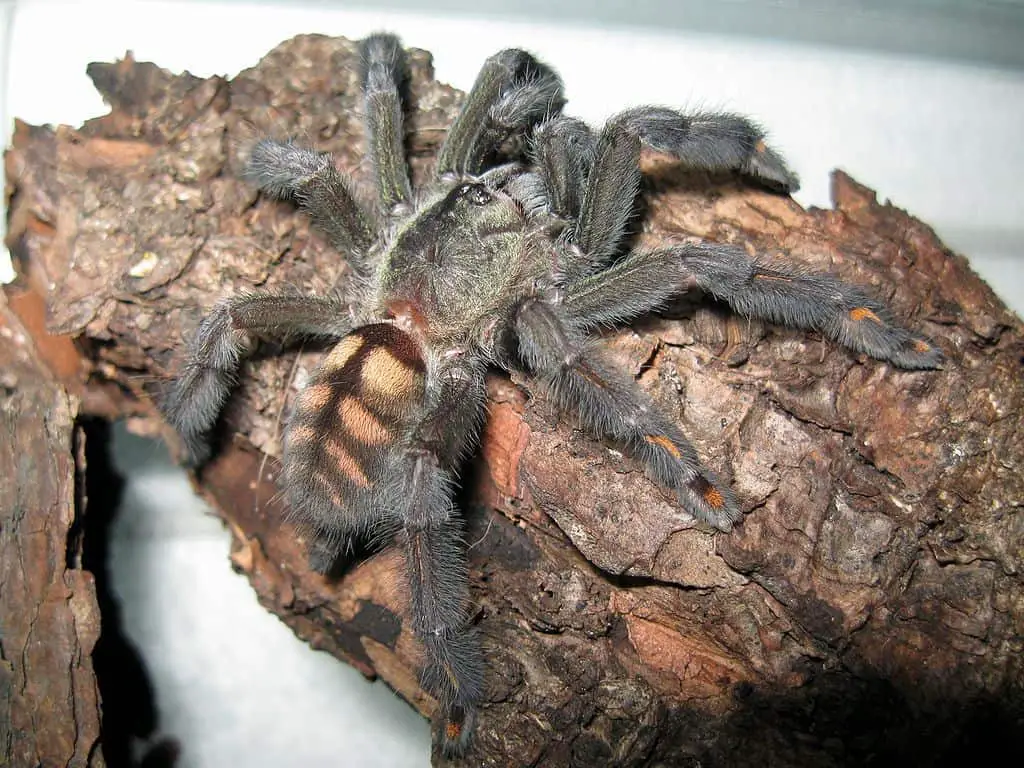
| Common Name | Venezuelan Suntiger Tarantula |
| Scientific Name | Psalmopoeus irminia |
| Type | New World, Arboreal |
| Leg Span | 5.5 inches (14cm) |
| Lifespan | Females 12 years / Males 4 years |
| Experience Level | Expert |
The Psalmopoeus irminia gets to this top thanks to her looks and behavior. She has a dark body with bright orange chevrons over the legs and a tiger-striped pattern on her abdomen. She lacks urticating setae, so you don’t have to worry about her flicking hair at you.
However, what she does have are aggressive behavior and strong venom, so it’s not a good fit for beginners. Nonetheless, she makes a fantastic display tarantula with a great feeding response.
9. Red Slate Pink Toe Tarantula
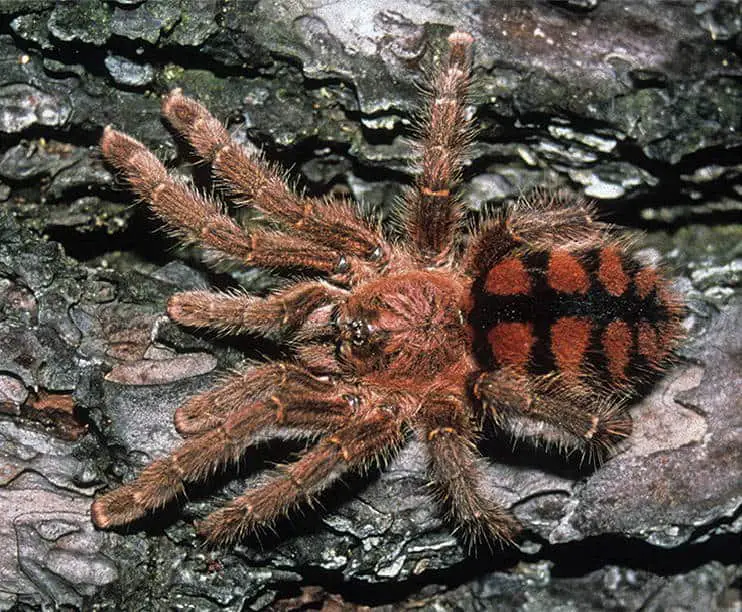
| Common Name | Red Slate Pink Toe Tarantula |
| Scientific Name | Avicularia minatrix |
| Type | New World, Arboreal, Dwarf Tarantula |
| Leg Span | 3 inches (7cm) |
| Lifespan | Females 10-12 years / Males 2-3 years |
| Experience Level | Beginner |
The second dwarf tarantula that reaches this top is the Red Slate Pink Toe Tarantula. This beautiful spider displays strong orange tones surrounding black patterns that make her beautiful and interesting.
She doesn’t get higher in this top because of her reclusiveness. She’ll spend most of her time out of sight; however, this makes it more special when you get to see her.
10. Feather Leg Baboon Tarantula
| Common Name | Feather Leg Baboon Tarantula |
| Scientific Name | Stromatopelma calceatum |
| Type | Old World, Arboreal, Bird Eater |
| Leg Span | 6 inches (15cm) |
| Lifespan | Females 12-15 years / Males 3-4 years |
| Experience Level | Expert |
We couldn’t finish this list without the Everest in the tarantula hobby, the Stromatopelma calceatum. This tarantula is popular for its fast movements, fantastic light and dark brown patterns, and short temper.
She’s unpredictable, fast, skittish, and strongly venomous, so she’s often considered a challenge even among species meant for expert hobbyists. However, if you consider yourself an expert in the hobby, this is the spider for you!
Final Words
Making a list of the best arboreal tarantulas wasn’t an easy task. There are too many beautiful spiders in this hobby, and narrowing them down to only ten was a long and thoughtful process.
However, we’re happy with the results, and we hope that so are you. We’re sure this list provides you with a selection of must-haves that should be in any collection.
- How Long Do American Eskimo Dogs Live? Important Factors and Care Tips - September 29, 2023
- Do American Bulldogs Need Grooming? Essential Tips and Care Guidelines - September 29, 2023
- Do Bengal Cats Enjoy Playing? Essential Tips for Keeping Them Active - September 29, 2023